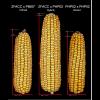Description
Yield gain has been a primary objective of maize breeding programs for the last century. Advancement in phenotyping tools, genomic methodologies, and data analytics strategies provide plant breeders with new tools to assess germplasm merit of experimental testcross hybrids, but more work is needed to integrate these systems into modern plant breeding schemes. The objective of this study was to assess genetic parameters and perform single- and multi-trait genomic prediction of grain yield and yield components in three testcross populations of either temperate or tropical descent. Two cross validation scenarios were implemented. In the first approach, five-fold cross validation was used with equal representation of each heterotic group across the five folds. In another scenario, training and testing sets originated from separate heterotic groups to evaluate prediction accuracy across heterotic groups. Where models were trained and tested on different heterotic groups, prediction accuracy was best when Iodent inbred lines predicted Non-Stiff Stalk inbred line performance due to the genetic similarity between these heterotic groups. Many yield components including ear area, ear length, and kernels per ear were more heritable and more accurately predicted based on single-trait genomic prediction than grain yield per plot or ear in the temperate and tropical populations. Multi-trait genomic prediction of grain yield per ear and grain yield per plot resulted in improved prediction accuracy in comparison to single-trait genomic prediction where secondary traits were known in the testing set. The integration of high-throughput yield component assessment with genomics could improve yield prediction in breeding programs.
Cite this work
Researchers should cite this work as follows:
- Tuinstra, M. R.; Tolley, S. A. (2023). Genetic Parameters and Multi-trait Genomic Prediction of Grain Yield on a Plot and Ear Basis in Temperate and Tropical Maize. Purdue University Research Repository. doi:10.4231/PQFT-7G59
